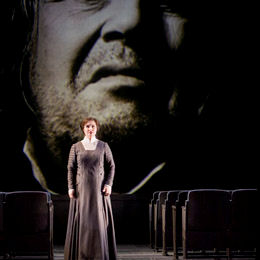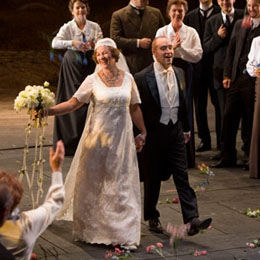|
|
|

Editorial
Board
London Editor:
(London UK)
Melanie
Eskenazi
Regional Editor:
(UK regions and Worldwide)
Bill
Kenny
Webmaster:
Bill
Kenny
Music Web Webmaster:
Len
Mullenger



|
MusicWeb is a
subscription-free site
Clicking Google adverts on our pages helps us keep it that way
Seen
and Heard International Opera Review
Wagner,
Götterdämmerung:
at the Royal Opera in Stockholm, 15.9.2007
(Premiere) (GF)
Sets and Costumes: Bente Lykke Møller
Lighting: Torben Lendorph
Choreography: Kristin Kåge
Movies: Mats Bäcker and Johan Forslind
Dramaturge: Stefan Johansson
Cast:
Siegfried - Lars Cleveman
Gunther - Gabriel Suovanen
Hagen - Hans-Peter König
Alberich - Kettil Hugaas
Brünnhilde - Katarina Dalayman
Gutrune - Lena Nordin
Waltraute - Helene Ranada
First Norn - Helene Ranada
Second Norn - Marianne Eklöf
Third Norn - Annalena Persson
Woglinde - Karin Ingebäck
Wellgunde - Susann Végh
Flosshilde - Karin Lovelius
Dancers: Hervor Sjöstrand, Kristin
Kåge and Elisabeth Crispin
The
Royal Orchestra
The Royal Opera Chorus
Conductor: Gregor Bühl

From the fairy-tale optimism of
development in Das Rheingold
with its colourful settings, its
technical evolution and the building
of Valhalla, the new Stockholm Ring
des Nibelungen has step by step
moved in time from Wagner’s own days
closer to present times and in pace
with this transportation grown ever
more sparse, even bleaker. In
Götterdämmerung we are well into
the twentieth century, around World
War One and the world is mainly in
black and white. The moving images of
the cinema have conquered the world
and essential parts of the opera take
place in a movie theatre, where
flashbacks are shown to remind the
audience of what has gone before. The
model is Fritz Lang’s Nibelungen
films. Even on other occasions filmed
sequences – in black and white –
accompany the proceedings. Thus the
three Norns – dressed in black and
white like waitresses - sing and act
on an empty stage against a backdrop
with three mime artists impersonating
the Norns of bygone days. Now they see
only a withered trunk of the World Ash
and then their thread entangles and
they can no longer foresee the future.
So much else is also withering. Both
Gunther and Gutrune are crippled,
Gutrune even bound to her wheel-chair
in the beginning and attended by two
nurses. Wotan is recurrently shown in
close up, grieved, mourning the world
of the Gods falling in pieces. There
is even interaction between the
present and the past when Brünnhilde
at the end throws the ring back to the
Rhine and on the screen it is caught
by Flosshilde. The Rhine overflows its
bank and on the screen we see actual
pictures filmed during the spring
flood.
Götterdämmerung
(or Twilight of the Gods) is of course
permeated by a sense of doom but also
by a hope for a new and better world
and since there is little in the way
of sets and props, focus is on the
individual characters. Removing
historical cobweb tends to clarify the
conflicts and relations – a good
example is the recent Amsterdam
Ring, directed by Pierre Audi and
available on DVD. There the orchestra
is placed centre stage with the
singers acting around it and sometimes
very close to the audience. In that
the Stockholm Ring is
traditional, but even though the Royal
Orchestra is half invisible in their
pit, they contribute greatly to the
general success. They have been
impressive throughout this Ring
and in Götterdämmerung, where
the orchestra play an even more active
part than in the preceding operas, they
grow in stature to challenge even
Barenboim’s Bayreuth players. It was a
fitting tribute to the musicians that
they were granted a curtain call on
their own on the premiere night. Gregor Bühl has shown increasing
understanding of Wagner’s scores and
in Götterdämmerung he fired his
forces to playing that was
overwhelming in its dynamic potency.

Director Staffan Valdemar Holm,
besides uncovering the inner selves of
the characters, has also, as in the
previous operas, played on the
humorous possibilities. This could be
devastating with less than sensitive
actors but with a cast of singers, who
also have the acting in their blood,
this just added a further dimension.
It should also be said that for a
Swedish speaking audience the
surtitles were a further help to
understanding. Sigrid Elmblad’s
interpretation, which was sung when
Götterdämmerung saw its Swedish
premiere exactly 100 years ago, is
closer to Wagner’s original, but that
also implies that for today’s viewers
there are too many cryptic linguistic
antiquities and Lasse Zilliacus’ new
rendering is much closer to our time
while still retaining a certain
solemnity, including alliteration. It
is fresh and done with tongue in
cheek.
During the last two years or so I have
seen and heard a number of recent and
not so recent Ring operas on CD
and DVD and my experience is that
however good the acting is and how
well the orchestras play one has to be
fairly indulgent towards the singing.
Real Wagner singers are not too numerous, even
in the great houses. Sweden, and
especially the Royal Opera, has a long
tradition in this field:I have
lavished praise on the previous casts
and several of those singers returned
also in Götterdämmerung. It may
sound chauvinistic but I don’t think
many opera houses in Europe can muster
a cast of such excellence with mainly
home-grown singers. There was hardly a
weak link. When did one see and hear a
trio of Rhine Maidens with such
freshness and such well tuned ensemble
singing? They were also the only
representatives of the good old days.
Their chequered dresses had paled a
bit but they still radiated youthful
innocence. The Norns were luxurious
casting indeed. The experienced
Marianne Eklöf was as expressive as
ever and Annalena Persson amply demonstrated
why she already has an international
career in the Hochdramatische Fach,
with ringing top notes of Nilssonian
brilliance – a Brünnhilde in the
making. Even more impressive was
contralto Helene Ranada, trained in
Sweden but having spent most of her
career in Germany. She was an
excellent Erda in Stuttgart’s recent
Siegfried (on both CD and DVD)
and here she doubled as a world class
Waltraute.
Lena Nordin, with a career of more
than 20 years, made a vivid portrait
of Gutrune, acting very convincingly
in this vocally a bit ungrateful role.
As her brother Gunther, Gabriel
Suovanen gave a touching performance
of this weak and sensitive character.
Kettil Hugaas confirmed through his
short appearance as Alberich that he
is a leading character singer today,
while Hans-Peter König’s Hagen was the
most formidably sung since Gottlob
Frick’s time – and that was 40 years
ago. Visually he was more a genial
landowner than the incarnation of
evil, but that only made his cruel
deeds the more abominable.
Lars Cleveman was the young Siegfried
a year ago and he was scheduled to
sing his older incarnation at some
later performances but due to illness
he was called to step in at the
premiere with only six hours’ notice.
Small of stature, he created a lively,
cheerful and carefree boyish Siegfried
and the brutality of his murder became
even more disgusting than usual. He
seems to have lungs of steel and vocal
cords of the same material, allowing
him to produce heroically ringing high
notes. His stamina is also admirable.
What one could possibly miss is a more baritonal timbre, but one can’t have
everything and having heard so many
tenors bawling and shouting their way
through this role it is a remedy to
hear it sung so securely and so
nuanced.
On top of all this excellence
Stockholm has a Brünnhilde probably
without peer in the world today.
Katarina Dalayman showed her
credentials in a superb reading of the
title role in Die Walküre a
year and a half ago, after which she
spent most of last year’s Siegfried
in her dressing-room, waiting for
the final scene. Now back in the
spotlight, she was deeply involved and
expressed the character’s
contradicting feelings with lyrical
sensitivity, razor-sharp vehemence and
on top of that a nobility and warmth
of tone that made her humanity stand
out. At her curtain call she was
deservedly greeted with standing
ovations.
There will be several performances of
this Götterdämmerung during this
autumn and later this season three
complete Rings will be given.
This is a cycle worth any Wagnerian’s
money and considering the overall
excellence it is only to be hoped that
some record company will grab the
opportunity to make it available on
discs and preserve it for posterity.
Swedish Radio have broadcast all the
parts. Just a hint!
Göran Forsling
Pictures © Matts Bäcker
Back
to the Top
Back to the Index Page
|
Seen and Heard, one of the longest established live
music review web sites on the Internet, publishes original reviews
of recitals, concerts and opera performances from the UK and internationally.
We update often, and sometimes daily, to bring you fast reviews,
each of which offers a breadth of knowledge and attention to performance
detail that is sometimes difficult for readers to find elsewhere.
Seen and Heard
publishes interviews with musicians, musicologists and directors
which feature both established artists and lesser known performers.
We also feature articles on the classical music industry and we
use other arts media to connect between music and culture in its
widest terms.
Seen and Heard
aims to present the best in new criticism from writers with a radical
viewpoint and welcomes contributions from all nations. If you would
like to find out more email Regional
Editor Bill Kenny. |
|
| |
|
Contributors: Marc
Bridle, Martin Anderson, Patrick Burnson, Frank Cadenhead, Colin
Clarke, Paul Conway, Geoff Diggines, Sarah Dunlop, Evan Dickerson
Melanie Eskenazi (London Editor) Robert J Farr, Abigail Frymann,
Göran Forsling, Simon Hewitt-Jones, Bruce Hodges,Tim Hodgkinson,
Martin Hoyle, Bernard Jacobson, Tristan Jakob-Hoff, Ben Killeen,
Bill Kenny (Regional Editor), Ian Lace, John Leeman, Sue Loder,Jean
Martin, Neil McGowan, Bettina Mara, Robin Mitchell-Boyask, Simon
Morgan, Aline Nassif, Anne Ozorio, Ian Pace, John Phillips,
Jim Pritchard, John Quinn, Peter Quantrill, Alex Russell, Paul
Serotsky, Harvey Steiman, Christopher Thomas, Raymond Walker, John Warnaby,
Hans-Theodor Wolhfahrt, Peter Grahame Woolf (Founder & Emeritus
Editor)
|
Site design: Bill Kenny
2004 |

